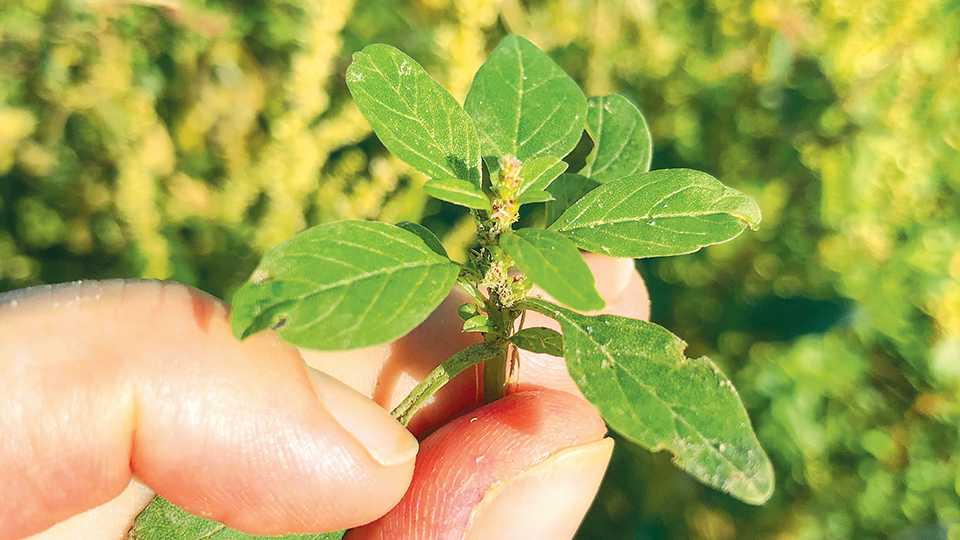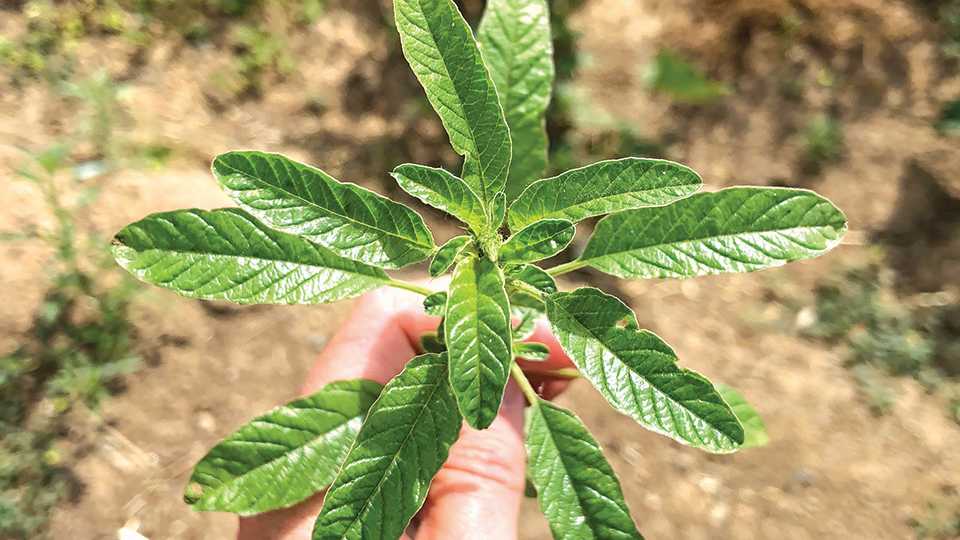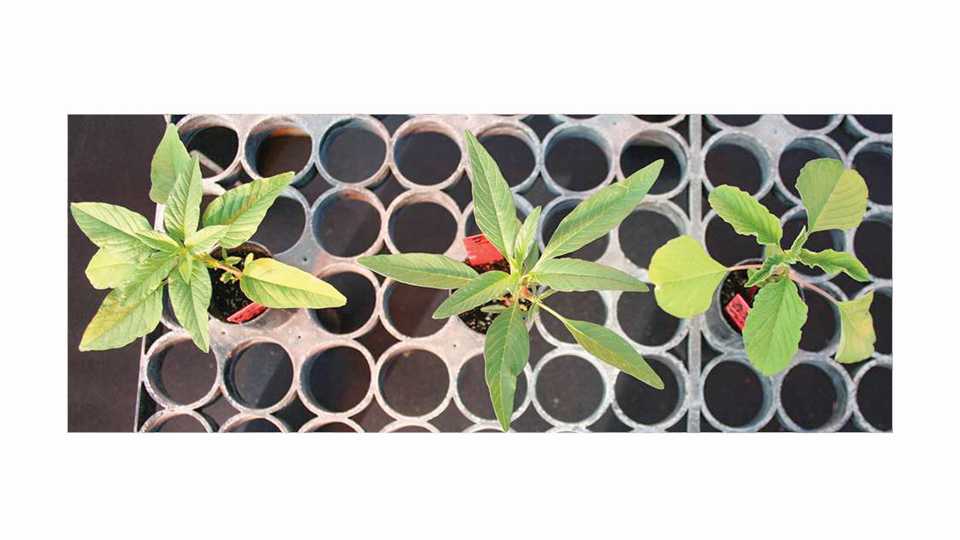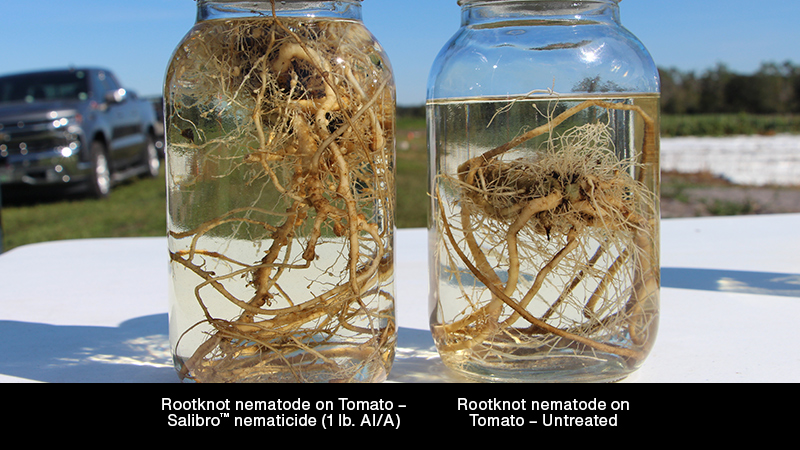Field Scouting Guide: Waterhemp
This latest edition of Field Scouting Guide concentrates on common waterhemp. Stephen Lawrence Meyers, Purdue University, and Lynn M. Sosnoskie, Ph.D., Cornell University, offer advice on how to spot and treat this weed.
BASICS
- Scientific name: Amaranthus tuberculatus
- Common name: Common waterhemp or tall waterhemp
- Geographical range: Predominantly the Midwest and the Great Plains states
- Crops affected:
Meyers: Based on surveys conducted by the Weed Science Society of America, pigweeds in general are among the most common and problematic weeds in agronomic crops like corn, soybeans, cotton, peanut, sugar beets, and pulse crops, as well as vegetable crops.
Sosnoskie: Cultivated fields — to date, mostly a concern of agronomic crop systems but could become an issue in specialty crops in rotation. Along roadsides and ditches, around ponds, near rivers and other wet areas, or seasonal wetlands.
PEST IMPACT
Meyers: Waterhemp has documented herbicide resistance to many types of herbicides including some photosystem II inhibitors, ALS-inhibitors, PPO-inhibitors, HPPD-inhibitors, synthetic auxins, and glyphosate. Some populations have resistance to multiple herbicides.
One reason for this resistance is that waterhemp is dioecious (male and female flowers on separate plants). It can produce hundreds of thousands of seeds per female plant.
I don’t have a number for the weed’s economic impact, but it would be a combination of the costs associated with treatment, yields and quality losses, and reduced harvesting efficiency. The total impact across all crops would likely reach into the tens of millions of dollars.
The greatest impact from waterhemp and most other weeds is when they emerge during a crop’s early growth stages. Crop plants have an exponential growth habit and interference for water, light, and nutrient resources early in crop development, which can have a tremendous impact on yield and quality at harvest. This critical period for weed control usually corresponds with crop canopy closure when the crop can effectively “shade out” emerging weeds. Later emerging waterhemp can still reduce yields, though not as significantly as early season waterhemp. Later emerging waterhemp also can contribute seeds to the soil seedbank and interfere with harvest operations.
Sosnoskie: We are in the process of formally evaluating the distribution of the species in New York State and characterizing population responses to commonly used herbicides. Preliminary data suggests resistance to at least three different herbicide classes.
Herbicide-resistant biotypes can have a significant economic impact, as resources need to be invested in developing alternate strategies to accommodate the loss of chemical tools.
If it is up and growing, it’s a problem. The situation is decidedly worse if the plants are flowering, as female waterhemp can produce hundreds of thousands of seed under optimal growing conditions.
IDENTIFICATION
Meyers: Waterhemp is most commonly mistaken for other pigweed species. It can be difficult to distinguish among pigweeds at the cotyledon, or seedling, growth stages. For this reason, waterhemp and similar species are often lumped together as pigweeds.
Sosnoskie: All of the amaranths resemble each other at the early seedling stage. At flowering, waterhemp most closely resembles Palmer amaranth, another amaranth that produces male and female flowers on separate plants.
Waterhemp’s leaves are a darker shade of green than Palmer amaranth and are long and oval, as compared to diamond-shaped (Palmer amaranth). The petioles of Palmer amaranth leaves are longer than the leaf blade; the petioles of waterhemp are shorter. Female waterhemp flowers do not possess the spiny bracts that Palmer amaranth does.
RECOMMENDED TREATMENT
Sosnoskie: Chemically, it depends on (1) the crop you are currently producing, as well as the crops you intend to rotate to (which defines the types of herbicides available); and (2) the herbicide resistance profile of your local populations.
According to the International Survey of Herbicide Resistant Weeds (weedscience.org), waterhemp populations across the U.S. have developed resistances to seven different modes of action; at least one population is known to be resistant to five different chemical classes.
In general, I recommend applying a residual, pre-emergence product followed by effective post-emergence products throughout the season. If possible, apply overlapping residuals to extend soil-based control. Alternate control strategies, such as crop rotation and cultivation, should be considered to diversify disturbances.
Are there any other things of note? Manage this species early to maximize the potential for control, and do not allow plants to produce seed, which can infest crops in following years. It’s a zero-tolerance threshold when it comes to seed return.
Meyers: For vegetable farmers, plastic mulch can be an effective control measure when it makes economic sense and you have drip irrigation. Avoid excessively large planting holes and tears in the mulch, which will allow for the emergence of waterhemp and other weeds. Weeds between rows will still need to be managed with either cultivation, shielded or directed applications of broad-spectrum, non-selective herbicides, or residual herbicides. Check local regulations, as some states have state-specific, special herbicide registrations for “row-middles.”
With few exceptions, vegetable crops lack effective, postemergence herbicide options for broadleaf weeds like waterhemp. Available post options rely heavily on Group 5 (PSII-inhibitors) and Group 2 (ALS-inhibitors) herbicides, two of the classes of herbicide waterhemp has documented resistance against.
For this reason, focus your chemical control on pre-emergence options. Because waterhemp can germinate throughout the summer growing season, successful management may require more than one pre application to provide greater season-long control.
Additionally, consider using more than one herbicidal mode-of-action. Commonly used herbicides that offer waterhemp control include chloroacetamides (Dual Magnum, Zidua), PPO-inhibitors (Valor/Chateau, Reflex), and dinitroanalines (Prowl, Treflan).
The drawback of using soil-applied, residual herbicides is that they require rainfall or irrigation to move the herbicide into the soil where weed seeds germinate.
An integrated weed management strategy will reduce reliance on herbicides. For fields without a history of waterhemp, or with low densities, consider exclusion and sanitation. This means that planting, cultivation, and harvesting equipment should be cleaned before entering “clean fields” by removing as much soil as possible. This is generally a good recommendation for all pests including nematodes and pathogens. Use only seed from lots that have been tested for and contain no waterhemp weed seed.
When possible, scout for rogue escaped waterhemp and remove them from the field.
Till in combination with other weed-management techniques. Because waterhemp are small seeded, only seeds in the uppermost soil profile will germinate and grow. Tillage that inverts the soil and buries them deeply into the soil can reduce waterhemp pressure and encourage decay of waterhemp seeds. When used to control emerged waterhemp, cultivation should target small seedlings to optimize control. If cultivation is the primary method of weed control used, multiple cultivation events may be required between crop establishment and canopy closure.

















